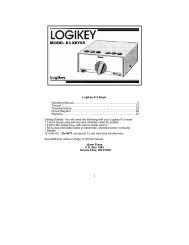4-BTV, 5-BTV, 6-BTV Multiband HF - K6RF Home of the Porta Base ...
4-BTV, 5-BTV, 6-BTV Multiband HF - K6RF Home of the Porta Base ...
4-BTV, 5-BTV, 6-BTV Multiband HF - K6RF Home of the Porta Base ...
You also want an ePaper? Increase the reach of your titles
YUMPU automatically turns print PDFs into web optimized ePapers that Google loves.
typically use a rubber mallet to drive it home. If <strong>the</strong> radial<br />
wire is sticking up any place due to uneven ground or <strong>the</strong><br />
wire is loose just put ano<strong>the</strong>r staple <strong>the</strong>re. The idea is to get<br />
all parts <strong>of</strong> <strong>the</strong> wire down as close as possible to <strong>the</strong> ground<br />
so that <strong>the</strong> grass can grow over it.<br />
When you finish <strong>the</strong> last radial, your job is done. Mo<strong>the</strong>r<br />
Nature will do <strong>the</strong> rest. If you have done this in <strong>the</strong> early<br />
spring, <strong>the</strong> grass will grow up, surround <strong>the</strong> wire and pull it<br />
down firmly along its full length. If you do it in <strong>the</strong> fall after<br />
<strong>the</strong> grass has stopped growing, it will happen <strong>the</strong> next<br />
spring. This will be done so completely that in a few weeks you will have to actively look for <strong>the</strong><br />
radials to see <strong>the</strong>m.<br />
Your mower will miss <strong>the</strong>m completely, too; but you and your contacts will hear <strong>the</strong>m right away!<br />
73,<br />
Paul - NO8D<br />
Note: Radial Wires shown above have Red insulation so <strong>the</strong>y would show up in <strong>the</strong><br />
photographs. DX Engineering Radial Wire has a relaxed Black PVC insulation.<br />
Radial System Considerations<br />
The performance <strong>of</strong> any quarter-wave vertical antenna, multi-band or single band, is completely<br />
dependent upon <strong>the</strong> quality <strong>of</strong> its radial system. A few local or medium range contacts may be<br />
possible using a minimal installation without radials. However, you will get more consistent results<br />
and much better performance with a complete radial system. The radial system required depends on<br />
whe<strong>the</strong>r it is for a ground-mounted or a ro<strong>of</strong>-mounted vertical and on <strong>the</strong> number <strong>of</strong> radials you can<br />
install.<br />
Many amateurs enjoy excellent quarter-wave vertical performance with only 20 to 30 radials. On<br />
ground-mounted quarter-wave verticals, <strong>the</strong> length <strong>of</strong> <strong>the</strong> radial wires is not<br />
critical. They can be as short as one-eighth wavelength, but one-quarter<br />
wavelength radials on <strong>the</strong> lowest band <strong>of</strong> operation are typical. Long lasting<br />
and high-efficiency radial wire connections are easy to make using <strong>the</strong><br />
stainless steel DX Engineering DXE-RADP-3 Radial Plate. Use <strong>the</strong> radial<br />
plate for a simple and neat way to install as many ground radial wires as you<br />
wish. Install 30 to 60 radials for higher performance using one or more DX<br />
Engineering radial wire kits. The relaxed black PVC insulated 14 gauge<br />
stranded copper wire in our Radial Wire Kits is easy to handle and will last far longer than bare wire<br />
or wire mesh.<br />
Why is such an extensive array <strong>of</strong> radial wires necessary? Simply put, it is <strong>the</strong> best way to increase<br />
your signal! The entire radial system must collect and carry currents equal to those flowing in <strong>the</strong><br />
- 14 -



